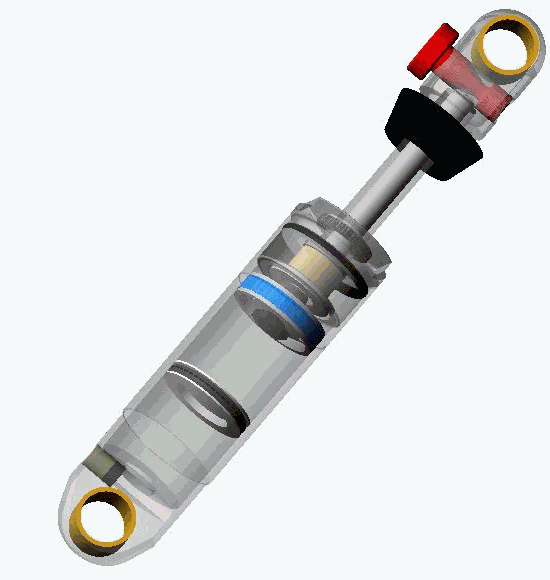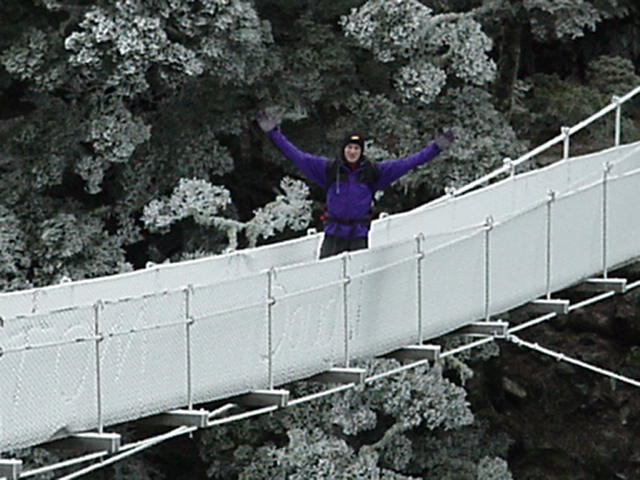Everything but pianos.
Contains:
First of all you shouldn't be reading this if you haven't already read my basic suspension setup guide Suspension setup.
And please don't try any internal changes to what you have before first writing down exactly what the stock internal setup is and how the parts came out.
I refer often to low or high damping speeds. This has very little to do with the speed of the bicycle or vehicle which the suspension is attached to, it is the speed at which the damper on the suspension is moving. This depends on the leverage ratio of the suspension, rising or falling rate, the shape of the obstacle hit and lastly on the speed at which the vehicle is travelling.
For example a wheel rolling off a gutter height ledge onto level ground is a low speed impact, onto ground sloping up could be a high speed impact. The same wheel rolling up the gutter at the same speed is a high speed impact because the square edge needs the suspension to compress a lot very quickly.
The larger the wheel is the lower the damper speeds will be as the contact point of the impact is more horizontal and less vertical.
A common misconception to damping is little low speed damping and lots of high speed damping will give a good ride by letting the wheel float over small impacts and ramp up on big impacts.
In reality the wheel is virtually uncontrolled over small impacts and floats too much. The high speed damping creates spikes in compression which cause the suspension to appear to lock before it uses enough of the travel to absorb the impact.
The result is a ride that ranges from wallowing and rocking to harsh through the midstroke and almost impossible to get full travel.
It may make it easier to think of damping oil and ports in terms of people and doorways.
Imagine you have a crowd of people and you need to control the speed they get from one room to another at.
If you have a small door and a large group of people trying to run through it, you reach a speed where you get a lot of pain and very few people through the door.
This is spiking.
Now we can make the door bigger so more people can get through faster, but then you can't slow down the groups that aren't already running.
Thinner people will also make it easier to get more through the hole faster, but this'll just shift the blocking up/pain threshold to a higher speed, not eliminate the problem (spiking) entirely.
You can't do much with a fixed size door.
Now imagine a door which opens more to let more people through. So when they're moving slowly you can still control the the group, but when they're all in a hurry you can let them all through without the pain.
This is how a shim stack damper works. It's like a door that opens further when it has to, to let more oil through.
Lastly imagine a door which takes a certain run up to open it.
This is a platform damper.
Orifice type dampers absorb energy by shearing oil while forcing all the damping oil through a fixed size hole (orifice) in the damper shaft on compression and rebound. Orifice type dampers give damping force proportional to the velocity of the oil squared. This means an impact of twice the speed generates four times as much damping force.
These dampers are not speed sensitive, they give almost no damping at low speeds yet generate damping spikes at the high compression speeds found on sharp edged impacts.
Orifice type dampers can be found in cheap motorcycle and car dampers, lower end marzocchi forks and RS hydracoil forks.
Shim stack dampers are found in all good rear shocks, manitou, fox, high end marzocchi and WB mountain bike forks and every other high performance motorcycle and car damper.
They consist of a piston with oil ports covered by shim stacks offering a flow path in each direction. There is often an adjustable bypass port (freebleed) which gives allows a small amount of oil to bypass the piston on rebound (and compression on non-platform dampers).
In operation the moving oil must flex the metal washers back to allow the oil to flow through. These are commonly referred to as speed sensitive dampers.
When the piston is forced through the oil jets are squirted out through the piston holes on the downstream side. The force produced by the jet of oil impacts on the shim stacks. The higher the speed of the oil jet, the more the shims bend backwards and the more oil can get through
How far the shims can bend back depends on the shape and size of the shim stack behind it. The combinations are close to limitless depending on on the application and desired effect. The two extremes are mimmicking an orifice damper (highly progressive damping) and a platform damper where a large force is required to get any movement, but once moving the shock offers very little resistance.
A low stack of large flat shims gives a large amount of low speed damping and soft high speed damping. A steep conical stack of washers (tapering from large to small) gives a lot of high speed compression damping to go with a lot of low speed damping.
The possibilities are endless, I haven't even scratched the surface.
All dampers require positive pressure to work properly. They can't work well in negative pressure where the oil is simply sucked through them. In this situation cavitation can occur which is the fluid being stretched into a gas, similar to boiling but it occurs at lower temperatures. When the gas bubbles collapse, shockwaves are sent through the damper which can become very destructive.
Another less destructive side effect is the loss of damping. As the fluid cavitates to gas, less oil is being sucked through the piston. Also on reversal the piston shoots back to the original position, sometimes kicking a hapless rider over the bars.
Do not attempt to take apart or service a rear shock unless you know exactly what you expect to find.
Many rear shocks contain pressurized nitrogen at up to 300psi. This is enough to fire parts into you, the wall or anyone watching. They literally blow up if taken apart wrong.
Oil damped rear shocks
These are the simplest, the spring is on the outside and is either a coil spring or air sleeve. The oil damper is inside and is close to identical regardless of air or coil spring.
Inside the damper is a volume compensator. This is usually a bladder or floating piston installed in the body eye end of the shock. It's purpose is to compress as the shock shaft enters the body and absorb the volume change. It also serves to prevent cavitation of the oil by keeping a positive pressure on the shaft seals and allow for heat expansion of the oil.
Most are filled and depressurized by a hypodermic needle through a neoprene seal. Common pressure is 175-200psi (but some are higher), dry nitrogen is used as it doesn't cause corrosion, doesn't introduce moisture into the shock and doesn't support combustion (explosion).
The endcap is usually thread on but some RS models are held by a circlip. The cap holds the shaft wiper, oil seal and shaft bushings.
Below the topcap on the shaft you'll find the main piston and shim stacks. This is normally made of aluminium with a teflon or nylon glide ring to help it both seal and run on the bore. There will also be a metering hole (freebleed) which runs through the middle of the shaft to allow a small amount of oil to bypass the piston and shims. On adjustable rebound shocks this metering hole is adjustable, the clicker on the shaft head moves an adjuster rod inside the hollow shaft to open or close the metering hole.
Further into the shock you'll find the nitrogen reservior for volume compensation. This is usually a seperate plastic piston (floating piston) which floats (funny that) up and down the bore seperating the shocks oil from the nitrogen charge. Some shocks have a bladder system instead of a floating piston, same result but more reliable through no moving parts.
Piggy Back shocks Some shocks have an external reservior attached. This is usually done for two reasons, one is to shorten the eye to eye length of the shock for any given amount of travel, this is acheived by moving the nitrogen reservior into the piggy back and out of the way. The other is to provide an ideal place to install an external compression damping adjustment. This is in the form of an adjustable choke on the orifice between the damper and the reservoir to slow the oil flow and the shocks movement. Best used to fine tune a shock for individual course conditions, big compression changes are best made in the shim stacks on the main piston.
  Me on the Rob-Roy bridge, West Branch of the Matukituki valley, July 7 2000. Temperature, -2C. Jacket by Dougal, Gloves by FOX, Bag by MACPAC, frost by nosunforawholeweek. |